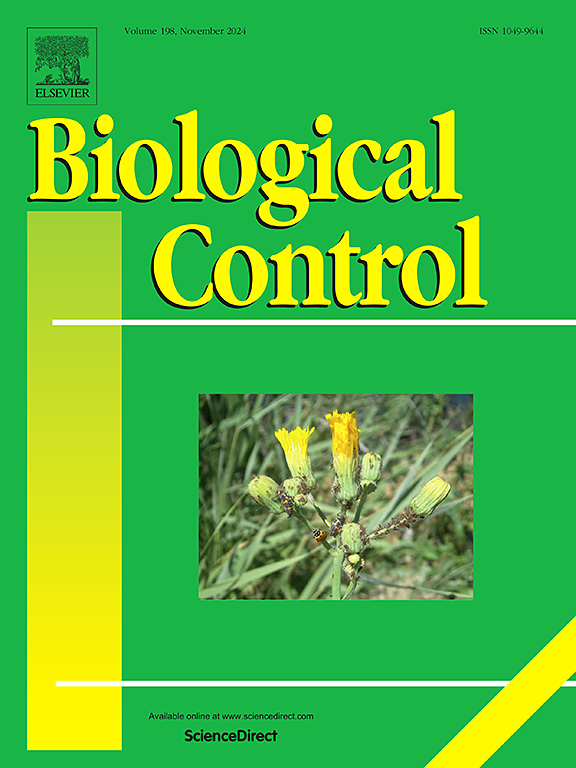RNAi-mediated suppression of toll-like receptor NlToll1 enhances Nilaparvata lugens susceptibility to entomopathogenic fungal infection
IF 3.4
2区 农林科学
Q2 BIOTECHNOLOGY & APPLIED MICROBIOLOGY
引用次数: 0
Abstract
The brown planthopper (BPH), Nilaparvata lugens, is the most devastating insect pest of rice. Biological control with fungal entomopathogens is an attractive alternative to chemical pesticides for controlling BPH. However, the efficacy of fungal bioagents is often limited by the immune defense responses of host insects. Toll-like receptors (TLRs) are a family of crucial pattern recognition proteins that are responsible for the immunologic recognition of invading pathogen in insects. Here, we demonstrated that the suppression of a key TLR-encoding gene NlToll1 in BPH through RNA interference (RNAi) could significantly improve the insecticidal efficacy of an entomopathogenic fungus Metarhizium anisopliae. The open reading frame (ORF) of NlToll1 was 3351 bp in length encoding a 126.7 kDa protein with a typical intracellular Toll/interleukin-1 receptor (TIR) domain, two transmembrane domains and 14 extracellular leucine-rich repeats (LRRs). The qRT-PCR results showed that the expression of NlToll1 had obvious spatiotemporal preferences and strongly induced by topical infection with M. anisopliae. Silencing of NlToll1 using RNAi led to a significantly reduced survival rate and an increased susceptibility of BPH fifth-instar nymphs to fungal infection, which might be partially owing to the immunosuppressive effects by repressing expression of antimicrobial peptide genes and the dysbiosis of gut bacterial community caused by NlToll1 silencing. Our results manifested that the combination use of RNAi and fungal entomopathogens would be an effective avenue for exploiting pesticide-free BPH management strategies.
rnai介导的toll样受体NlToll1的抑制增强了褐飞虱对昆虫病原真菌感染的敏感性
褐飞虱(Nilaparvata lugens)是水稻最具破坏性的害虫。真菌昆虫病原生物防治是一种有吸引力的替代化学农药防治BPH的方法。然而,真菌生物制剂的功效往往受到寄主昆虫免疫防御反应的限制。toll样受体(Toll-like receptor, TLRs)是一类重要的模式识别蛋白,负责昆虫对入侵病原体的免疫识别。在此,我们证明了通过RNA干扰(RNAi)抑制BPH中tlr编码关键基因NlToll1可以显著提高昆虫病原真菌绿僵菌(Metarhizium anisopliae)的杀虫效果。NlToll1的开放阅读框(ORF)长度为3351 bp,编码一个126.7 kDa的蛋白,具有典型的细胞内Toll/白细胞介素-1受体(TIR)结构域、2个跨膜结构域和14个细胞外富亮氨酸重复序列(lrr)。qRT-PCR结果显示,NlToll1的表达具有明显的时空偏好,且受局部感染的诱导。使用RNAi沉默NlToll1导致BPH五龄若虫的存活率显著降低,对真菌感染的易感性增加,部分原因可能是通过抑制抗菌肽基因的表达和NlToll1沉默引起的肠道细菌群落失调而产生免疫抑制作用。研究结果表明,RNAi与真菌昆虫病原体的联合使用将是开发无农药BPH管理策略的有效途径。
本文章由计算机程序翻译,如有差异,请以英文原文为准。
求助全文
约1分钟内获得全文
求助全文
来源期刊

Biological Control
生物-昆虫学
CiteScore
7.40
自引率
7.10%
发文量
220
审稿时长
63 days
期刊介绍:
Biological control is an environmentally sound and effective means of reducing or mitigating pests and pest effects through the use of natural enemies. The aim of Biological Control is to promote this science and technology through publication of original research articles and reviews of research and theory. The journal devotes a section to reports on biotechnologies dealing with the elucidation and use of genes or gene products for the enhancement of biological control agents.
The journal encompasses biological control of viral, microbial, nematode, insect, mite, weed, and vertebrate pests in agriculture, aquatic, forest, natural resource, stored product, and urban environments. Biological control of arthropod pests of human and domestic animals is also included. Ecological, molecular, and biotechnological approaches to the understanding of biological control are welcome.
 求助内容:
求助内容: 应助结果提醒方式:
应助结果提醒方式:


